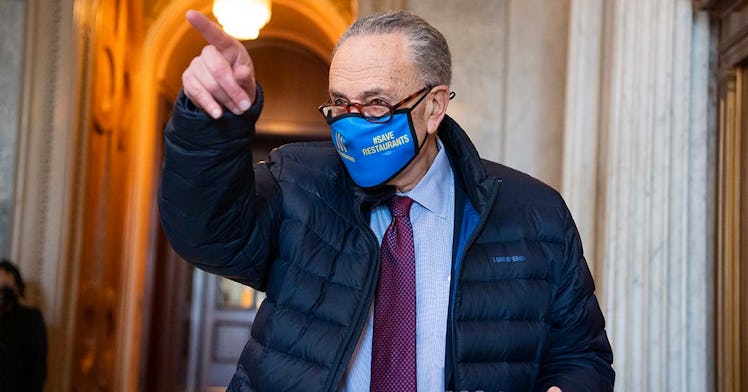COVID-19 Relief Package Passes Senate, Stimulus Checks Could Start To Go Out This Weekend
There's a lot for parents to be excited about.

On Saturday morning, after 26 hours of debate, a weary Senate voted along party lines to advance a $1.9 trillion COVID-19 relief package. Now, it looks destined for passage by the House, which will vote on the legislation on Tuesday, and Joe Biden’s signature before the end of the week.
The package will have far-reaching effects on Americans’ lives, particularly those of working parents. Here’s what you need to know about the next round of stimulus payments, the newly expanded child tax credit, and the rest of the bill.
What does the stimulus package look like?
The stimulus that made it into the final bill has a maximum amount of $1,400, which will go to individuals earning up to $75,000, and $2,800 for couples making up to $150,000.
In exchange for keeping those thresholds from the last round of stimulus payments in December, progressive Democrats accepted a much faster phase-out from the conservative members of their party concerned that too many people would benefit from the policy. Payments will decrease with income over those thresholds up to $80,000 for individual filers and $160,000 for joint filers.
Adult and children dependents will add $1,400 apiece to stimulus payments even if the filer(s) don’t receive the maximum amount.
Assuming that the bill passes the House promptly, at least one analyst thinks that stimulus check payments could start landing in bank accounts by next weekend.
How is the Child Tax Credit changing?
Dramatic changes to the child tax credit have flown somewhat under the radar, but they will be transformative for families, particularly low-income families. The credit will increase from $2,000 to $3,600 for dependents under 6, from $2,000 to $3,000 for dependents 6 to 16, and from $500 to $3,000 for 17-year-old dependents. This could give families thousands of extra dollars a year to help raise their children and would dramatically cut child poverty.
The new child tax credit will also be fully refundable. Before, if a family paid too little in taxes they wouldn’t receive the entire benefit. Now, even if a family pays nothing in income taxes they will receive the entire amount.
What’s more, half of the credit bill be applied to income taxes at the end of the year but the other half will go out in monthly checks, starting in July. That means parents will get a regular, reliable source of money throughout the year.
And while the changes will last for just one year under the law, Democrats are optimistic that they can make the program permanent. At least one analysis found that, if that happens, child poverty in America would be nearly in half.
What else is in the Senate bill?
On the off chance you didn’t spend 10 hours and 44 minutes listening to the Senate clerks read all 628 pages of the bill per Sen. Ron Johnson’s unnecessary request, here’s some of what’s in it.
- An extension of $300 weekly unemployment benefits through September
- $350 billion for state and local government aid, some of which is earmarked for capital projects
- $130 billion to help reopen schools and colleges
- $30 billion in assistance for renters and landlords
- $50 billion for small business assistance
- $160 billion for vaccine development and distribution
After early talks with Republicans didn’t go anywhere, Biden and Senate Dems elected to use the budget reconciliation process, so the bill as it will pass is the product of intraparty deliberation, not a bipartisan process.
What isn’t in the bill?
The big thing that’s missing from the version of the bill the Senate is debating today is a gradual, long-overdue minimum wage increase to $15 an hour. The Senate parliamentarian advised the Democrats, in a non-binding ruling, that it wasn’t allowed under the rules of budget reconciliation. Sen. Bernie Sanders will offer the minimum wage as an amendment. Every Republican and eight Democrats voted against it, so it will not be included in the final bill.
Also missing are the original more generous versions of the stimulus payment. The stimulus was trimmed from $2,000 to $1,400, then the upper-income limit was lowered to $100,000, and then it was lowered to $80,000, cutting 12 million people off from the benefit.
The unemployment benefit was supposed to increase the weekly payment to $400 and extend the benefit through August. But at the last minute, Sen. Tom Carper proposed a change. His plan would make it a $300/week payment that will be extended through September. According to some analysts, although this looks like a less generous offer in the stimulus package, it could actually put more cash in people’s pockets.
Elizabeth Pancotti, a policy director at Employ America, noted that while $2,400 in federal pandemic unemployment insurance was deducted from the bill, the average worker, with the combination of longer-running unemployment insurance and more tax forgiveness, will have about $1,620 more in their wallets than in the House version of the bill.
But for that to happen, Sen. Joe Manchin would have to sign on, something that he has yet to do. In fact, Manchin is being courted by GOP Sen. Rob Portman, who was pushing an extension at $300 a week only in to July.
When will it pass the House?
Allegedly, Tuesday, March 9th. Speaker Nancy Pelosi scheduled a vote on the Senate version of the legislation on Tuesday. Assuming it passes, Biden will sign it before turning to his next legislative priority: a plan to correct the abysmal state of America’s infrastructure.
This article was originally published on